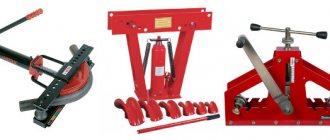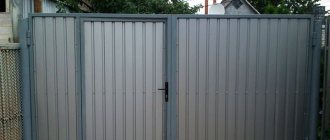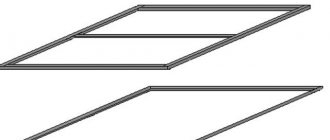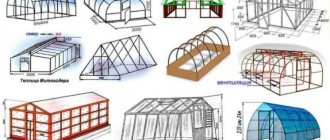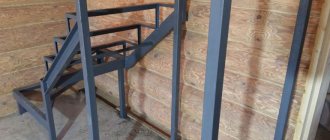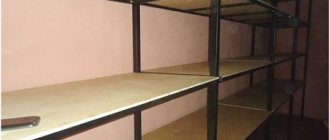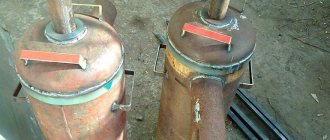A profile pipe bending machine is a very popular type of metalworking equipment. This is explained by the fact that pipe products of this type are today actively used in many areas, including for solving domestic needs. If cutting a profile pipe is easy to do even with hand tools, then to bend such a product it is necessary to use a special pipe bending machine.
Bending a profile pipe on a homemade machine
There may be only two options for obtaining such a machine at your disposal: purchasing serial equipment, for which it will be necessary to allocate significant financial resources, or making a device for bending profile pipes with your own hands. Today there are many design schemes according to which homemade machines for bending profile pipes can be made. It is worth dwelling in more detail on the simplest of them and, accordingly, the most popular among home craftsmen.
Device options
There is a proven old-fashioned method, but its effectiveness is low, and, on the contrary, its labor intensity is significant. To do this, take a hollow pipe, fill it with sand, and close both ends with plugs. Then you need to take a gas burner and heat the area red-hot. To avoid involuntary bending, it is recommended to use a stencil, but most such procedures are carried out simply with the help of any strong steel bar against which the metal can be rested. But in order to obtain sufficiently high accuracy, as well as to make the whole process much easier, craftsmen use pipe benders.
Types of devices:
- Lever. They work like a classic lever, that is, you need to apply force at one end and install the other in a template.
- Manual.
- Drones.
- Crossbow.
The latter are highly valued among specialists, since they can be used to bend even very short tubes without heating the part.
Operating principle of a pipe bender
The basic process is very simple: the pipe undergoes a significant temperature change, the steel becomes more pliable. The workpiece is then placed in a rolling device between three shafts, which also serve as a model. The radius of the future element depends on their location and diameter. All rollers are divided into guides and pressure rollers. The former only hold the part, while the latter set the angle of curvature. Note that repeated changes in state (both heating and deformation) lead to a loss of strength.
Classification by drive type
Depending on the complexity of the task, the type and radius, as well as the material of the workpiece and the required accuracy, level of production, different machines may be required:
- Hydraulic. They can be used to bend three-inch elements. They are very productive, have high speed and accuracy.
- Electromechanical. Designed for a larger diameter, they are most often used for working with main pipelines.
- Manual. They are driven by a person, so the pressing force is only enough for small professional pipes.
Make or buy?
If you have the financial resources to purchase equipment for developing production or doing cold forging yourself, you can focus on choosing suitable models . There are many domestic and foreign companies offering machines that take into account all the requirements and wishes of customers. The main thing is that the financial capabilities of the buyer coincide with the prices of the equipment manufacturer: manual and electric, of different types: snail, flex, flashlight, twister and others.
How to make a homemade pipe bender for a profile pipe with your own hands using a template
This method is suitable for beginners and home use. To do this, you will need wooden boards - their size should be 1 cm on each side greater than the diameter of the structure. It is necessary to provide a slope at the ends, this allows the workpiece not to move off the device. The resulting stencil must be firmly installed on the surface; a flat floor will do. Nearby there is a holder, already metal, it is needed for support.
The corrugated pipe is placed between these two elements and gently pressed against the sample. If you mount the lever, the process will be much easier. Pros:
- Ease of execution.
- Economical.
Minuses:
- Low accuracy, large errors.
- The wooden template is only suitable for one specific bend angle.
Do-it-yourself “Snail” pipe bender for professional pipes, drawings: how to make a machine
Let's look at the schematic diagram with the given parameters:
The device is great when you need to make several identical products. Its advantages include a fairly simple design, and the installation is small in size. But there is also a significant drawback - the bending radius will be small.
Rental device
The main advantage of this device is its versatility, as well as its electric drive. In other cases you have to work manually, but here you just need to connect the engine. The principle of the mechanism still remains the same - there are three shafts, between which a corrugated pipe is stretched. The rollers are movable and can be replaced according to the required angle. Let's look at the video to see how the mechanism works. Here is a manual version, without a motor, so it’s easier to do it yourself.
Machine Operation and Maintenance
malfunctions rarely occur during its operation .
But, despite this, you should still regularly check the performance of its components and prevent exposure to aggressive environmental factors. The greatest threat to it is precipitation. First of all, the rolling rollers should be protected from contact with moisture, as this is fraught with the formation of rust. To solve this problem, you can use a tarpaulin shelter.
of creating a portable pipe bender was initially considered , then a dry room should be used as a storage place for it. Having finished bending profile pipes, the machine must be put in order and dust, dirt and sand must be removed from its working units. In order for stationary machines for bending profile pipes equipped with an electric drive to demonstrate high productivity and operational efficiency over a long period of time, they must be provided with regular maintenance and preventive maintenance.
Important design elements
Regardless of which type suits you best for the upcoming tasks, two opposing forces will be presented - one static, which just rests on the pipe and bends it (shaft, angle, wooden template), the second, accordingly, is dynamic, it leads the whole mechanism is in motion. This device is convenient in that, based on the position, you can change the size of the bend, and bending is available over a large radius. The best option in this regard is considered to be a rolling pipe bender; you can make it yourself. Even though it is the most difficult to create, it will be in use for several years. It structurally consists of the following elements:
- Three metal rollers.
- Chains for drive transmission.
- Rotational axis.
- An electric drive (engine) or a manual device - a rotary handle with a sufficiently large lever.
- Metal base - bed.
If the shafts are made not from steel (suddenly there is no metal lathe), but from wood or polyurethane, then you need to carefully consider the strength of the selected materials. If you plan to bend fairly massive pipes, then there is a possibility that the equipment simply will not hold up.
Types of roll forming machines
Roll benders are divided into three main categories.
Hydraulic
These are the most powerful of the profile benders, used primarily to equip industrial enterprises. A hydraulic type roll bending machine belongs to the category of stationary equipment; with its help, at production enterprises, you can efficiently and quickly bend profiles of any section in any quantity. The hydraulic profile bender has such significant advantages as ease of operation and the absence of the need to use physical force during the bending process. The only drawback of such profile benders is that they require a connection to an electrical network to operate.
Hydraulic roll forming machine - HPK 65
Electric
Although this equipment is smaller in size than hydraulic, it also falls into the category of stationary. The use of electric profile benders makes it possible to produce bent contours that exactly match the drawing, as well as to ensure the strength of the finished products at the bend points. Electric profile benders are used to equip small enterprises and workshops (that is, where there is no need to bend large cross-section profiles). There is also electromechanical equipment that operates semi-automatically under operator control.
Homemade profile bending machine with electric drive
Manual
Such equipment for bending metal profiles is characterized by its small size, ease of operation and affordable price. It is the manual profile bender that can most often be found in private workshops or garages, where it is used to, if necessary, make a bent profile from a metal profile or a pipe of small cross-section. It should be borne in mind that when using such a profile bender, it is almost impossible to control, much less obtain, a bend that corresponds to the drawing. In addition, to bend a profile or pipe using a manual profile bender, you will have to exert significant physical effort. However, all these disadvantages are more than compensated by the affordable cost of a manual profile bender, especially when compared with the price of hydraulic or electric machines.
Universal manual profile bending machine PG-4
DIY profile pipe bender: drawings and process
Let's show a diagram of one of the presented options:
You will need to do the following:
- Weld a strong base. Connections can be not only welded, but also bolted.
- Place the shafts - two are higher, they are on the same plane with each other, and the third is lower. What distance there will be between them depends on the required specified bending radius. We recommend making several holes for removable fasteners so that you can easily re-qualify the device.
Details in the table:
| Standard | returnable and reducing dimensions (respectively), (mm) | ||||||
| diameter, mm | bending radius (mm) | at 45° | at 90° | at 180° | |||
| 6 | 18,0 | 7,0 | 0,8 | 18,5 | 8,0 | 18,5 | 20,0 |
| 8 | 24,0 | 9,5 | 1,0 | 24,0 | 12,0 | 24,0 | 27,0 |
| 10 | 30,0 | 11,5 | 1,3 | 30,5 | 14,5 | 30,5 | 34,0 |
| 12 | 36,0 | 14,0 | 1,5 | 36,5 | 15,0 | 36,5 | 37,5 |
| 14 | 47,5 | 18,5 | 2,0 | 48,5 | 20,5 | 48,5 | 52,5 |
| 15 | 54,0 | 21,0 | 2,3 | 56,0 | 54,5 | 56,0 | 58,0 |
| 16 | 58,0 | 22,5 | 2,5 | 64,0 | 28,5 | 64,0 | 67,0 |
| 18 | 66,0 | 25,5 | 2,8 | 68,0 | 31,0 | 68,0 | 72,0 |
- Next, the chain is tensioned; it should pass through three gears and be well tensioned.
- Attaching a handle to drive one shaft will be a manual drive.
Instructions for making a simple electric pipe bender for a profile pipe with your own hands
Metal can become a fairly flexible and flexible material if you properly equip a homemade machine. Let us list the stages of its creation:
- Drawing development. You can use ready-made ones on this site or create your own individual scheme with specified parameters.
- Prepare the shafts; they need to be ground. We recommend leaving small edges on the sides; they will help prevent the workpiece from jumping off.
- Make holes in the rollers and cut threads into them. A similar procedure is required for shelves to install the pressure element.
- After preparing the parts, proceed to assembly starting with the frame.
- Install the shafts - the clamping one should be suspended on springs, while the remaining two should be placed on the sides on the support bar.
- Now attach the jack (or handle).
Manufacturing of hydraulic pipe bender
Hydraulics are quite capricious in execution, however, if you have professional turning knowledge and skills, as well as the equipment necessary for such work, you can start creating a pipe bending machine for a profile pipe with your own hands. You will need a hydraulic cylinder, a blower and stops for the corrugated pipes. Let's look at the video on how to make the product yourself:
Unlike factory equipment, home equipment will be made not from metal strips, but from corners and channels. This increases the weight of the structure, but at the same time makes it more static and reliable - you can work with strong materials. The pipe bender consists of:
- from the bed;
- two bearings;
- semicircular nozzle;
- hydraulic jack.
So that the thrust rollers can be mixed in one direction or another, 5-6 holes need to be made in the base. The procedure is very simple. The shafts are placed in the places made for them, the jacking device is placed under the frame, and the nozzle is placed on its upper part. A pipe is inserted between the elements. The specialist manually begins to move the lever, thereby bending the workpiece.
Bending methods
There are two main methods:
- Cold – the product is not preheated. Accordingly, the level of fusibility and flexibility is low. This means that procedures cannot be carried out with a significant change in angle, only small bends. It is first necessary to fill the internal cavity with sand or salt, this will improve the result and minimize the possibility of splitting.
- Hot – relevant for materials with high rigidity, strength, as well as workpieces with thick walls. The procedure is simple - using a gas burner, heat the area that will be metalworked.
Photo of a home pipe bender
Useful tips
- The clamping screw is less functional than a regular jack, try replacing this part.
- Use metal hooks - they can be used to secure the workpiece so that it does not jump off the shafts.
- If you are not sure about the dimensions of a pipe bender for a profile pipe and the calculations when making it yourself, we suggest that you first make a preliminary mock-up made of wood, which will allow you to evaluate the correctness of your calculations. Metal elements can then be turned using this template.
- Be sure to think in advance about how to remove and reinstall the rollers - this can make the device universal and applicable not in one case, but constantly.
- Most parts of the structure can not be purchased, but can be found at home or even at a scrap metal collection point. For example, the chain on the drive is similar to a regular one from a motorcycle or car, and the bearings can be machined from ordinary automobile shafts at the base of the wheel.
Universal
Cold forging equipment can be versatile. Using one piece of equipment it is possible to produce workpieces of various shapes: baskets, arcs, curls, rings, torsion bars and other types. Such machines are produced by specialized enterprises and their cost is high.
Universal forging machine Blacksmith UNV2. Photo VseInstruments.ru
Machines with a lesser degree of versatility can be made independently. If you add an additional gate to a snail machine with a rotating template, made by yourself, you will get wave-type blanks.
However, a cold forging machine with maximum versatility should not be made independently, due to its great technical complexity. Here this issue is best left to serious companies.
